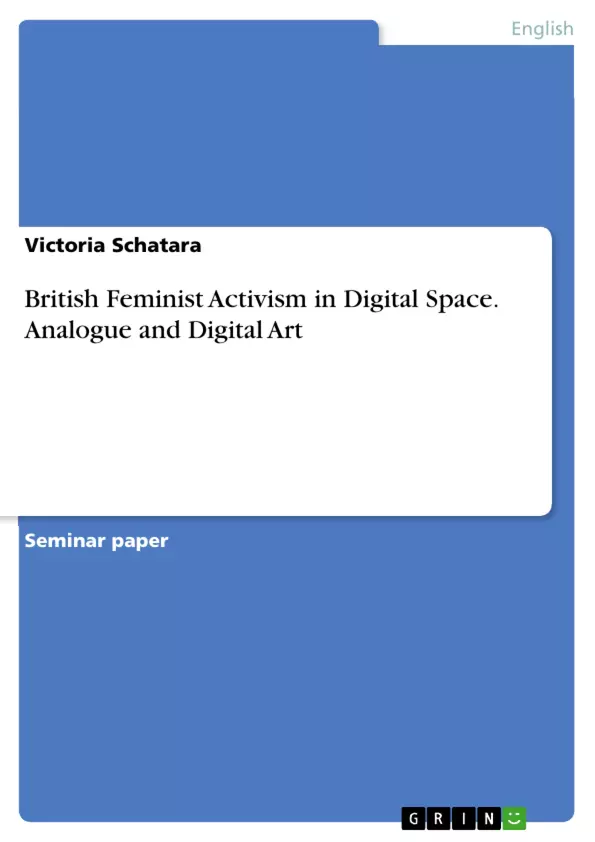This paper analysis how British feminist Activism is shown in Digital Spaces. In the next chapters, I will focus on how British feminists both use the digital space as the medium of their agenda and examine it as a subject of their art and whether and if so, how their works contrast with other Western feminisms.
After outlining features characteristic of contemporary British feminist activism and art and their relation to the digital space, I will provide and analyze some examples of feminist analogue and digital art on the internet. Regarding the fact that the majority of scholars consider the fourth wave to have been initiated by the rise of the internet and, more concretely, social media, it is the starting point of this paper with the other waves being neglected. The first part will cover theory, whereas the second one will then closely look at how this is realized in practice. Whereas there is a relative wealth of papers examining feminism and the digital space, the research on how all this looks online is rather limited, requiring a more practical and extensive approach.
Inhaltsverzeichnis (Table of Contents)
- Introduction
- 1. Contemporary British Feminist Activism (and/in Digital Space)
- 1.1. (British) Modern Feminist Ideas and Politics / Forth Wave of Feminism
- 1.2. Feminist Activism and/in the Digital Space
- 1.2.1. British Online Feminism
- 1.2.2. Feminist Art and/in Digital Space
- 2. British Feminist Art on the Internet
- 2.1. Analogue Art
- 2.1.1 Online Galleries/Websites
- 2.1.1.1. 100% Women, A Room of One's Own
- 2.1.2. Databases
- 2.1.2.1. N.Paradoxa
- 2.1.3. Individual Websites / Blogs
- 2.1.3.1. Artisanal art
- 2.2. Digital Art
- 2.2.1. Websites
- 2.2.1.1. Girlgaze
- 2.2.2. Individual Websites
- 2.2.2.1. Comics
- 2.2.3. Social Media
- 2.2.3.1. Digital Illustrations
- 2.2.3.2. Photography
- 2.2.3.3. Videography
- The role of the internet in the development of contemporary British feminist activism and art
- The relationship between British feminist art and activism in the digital space and broader Western feminist movements
- The use of digital media, including online galleries, social media platforms, and individual websites, by British feminist artists
- The impact of new media on feminist discourse, communication, and representation
- The intersection of feminism, technology, and social change
Zielsetzung und Themenschwerpunkte (Objectives and Key Themes)
This paper contributes to the history of feminist art, particularly focusing on contemporary British feminist art and activism in digital spaces. The primary aim is to examine how British feminists utilize the internet both as a platform for their agenda and as a subject of their art, drawing comparisons to Western feminist movements. The paper explores the evolution of feminist art and activism within the context of new media, particularly the internet, and its impact on communication, meaning-making, and representation.
Zusammenfassung der Kapitel (Chapter Summaries)
The introduction of this paper sets the stage by highlighting the crucial need for a robust history of feminist art and activism, particularly in the digital realm. It traces the evolution of feminist art and activism from its roots in the 1960s and 1970s to its current manifestation in the digital sphere. The paper emphasizes the need to understand how British feminists utilize digital spaces to promote their agenda and analyze how their works compare to those of other Western feminisms.
Chapter 1 explores the concepts and political landscape of contemporary British feminist activism, situating it within the broader global feminist movement. It analyzes the features that distinguish the "fourth wave" of feminism, emphasizing the role of the internet and social media in shaping its discourse and practices. Key topics discussed include the normalization of "everyday sexism," the critique of capitalism, and the representation of women in media and other spheres.
Chapter 2 delves into the world of British feminist art in the digital sphere, exploring both analogue and digital forms of art. It examines online galleries, websites, and social media platforms as spaces for showcasing and promoting feminist art. The chapter explores the diverse range of media utilized by British feminist artists, including photography, video, digital illustrations, and comics. It analyzes how these forms of art contribute to the broader feminist discourse and challenge dominant narratives.
Schlüsselwörter (Keywords)
The key terms and concepts explored in this paper include: British feminist art, digital space, fourth wave feminism, online activism, social media, feminist discourse, representation, new media, digital art, analogue art, online galleries, websites, social media platforms, photography, video, digital illustrations, comics, and intersectionality. These terms encapsulate the primary themes and foci of the research, highlighting the interplay between feminist theory, art, and the evolving digital landscape.
- Quote paper
- Victoria Schatara (Author), 2020, British Feminist Activism in Digital Space. Analogue and Digital Art, Munich, GRIN Verlag, https://www.hausarbeiten.de/document/947397


